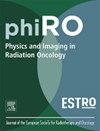锥形束计算机断层扫描的剂量不确定性建模:基于深度学习的合成计算机断层扫描生成的预测方法
IF 3.4
Q2 ONCOLOGY
引用次数: 0
摘要
背景与目的:锥形束计算机断层扫描(CBCT)在图像引导放射治疗(RT)中对患者定位和每日剂量计算至关重要。然而,CBCT的CT数波动较大,与计算机断层扫描(CT)的CT数不同,需要合成CT (sCT)生成来提高剂量计算的准确性。在临床实践中,cbct与sct的合成仍然是一项具有挑战性和不确定性的任务。本研究旨在引入与sCT和CT之间误差相关的体素不确定性估计器。材料和方法:选择85例头颈部(H&;N)患者进行单中心光子放射治疗,以开发和验证我们的不确定度估计方法。为了检验该方法在非分布图像上的稳健性,另外纳入了来自不同中心的三名患者。我们提出的不确定性估计方法建立在现有的常规技术基础上。此外,为了探索潜在的错误情况,我们生成了几个“合理的”sCT,代表了由CBCT质量差异引起的sCT生成的变化。这使我们能够量化剂量的不确定性。结果:通过将不确定性图与sCT和CT之间的绝对误差图相关联来评估不确定性图的有效性,Pearson相关系数在0.65 ~ 0.72之间。剂量不确定度通过剂量-体积直方图(DVH)确定。除1例患者外,所有患者的参考CT DVH均包含在由sct衍生DVH定义的不确定性区间内。结论:我们提出的方法有效地预测了有助于评估sCT质量的不确定性图。该方法还提供了一种新的方法,通过使用估计的sCT不确定性定义CT DVH周围的置信区间来估计剂量不确定性。本文章由计算机程序翻译,如有差异,请以英文原文为准。
Modeling dose uncertainty in cone-beam computed tomography: Predictive approach for deep learning-based synthetic computed tomography generation
Background and purpose:
Cone-beam computed tomography (CBCT) is essential in image-guided radiotherapy (RT) for patient positioning and daily dose calculation. However, CT numbers in CBCT fluctuate and differ from those in computed tomography (CT), requiring synthetic CT (sCT) generation to improve dose calculation accuracy. CBCT-to-sCT synthesis remains a challenging and uncertain task in clinical practice. This study aims to introduce a voxel-wise uncertainty estimator correlated with the error between sCT and CT.
Material and Methods:
Eighty-five head and neck (H&N) patients treated with photon RT from a single center were selected for developing and validating our uncertainty estimation method. To test the method’s robustness on out-of-distribution images, three additional patients from different centers were included. Our proposed uncertainty estimation method builds on established conventional techniques. Additionally, to explore potential error scenarios, we generated several ‘plausible’ sCTs representing variations in sCT generation caused by CBCT quality differences. This allowed us to quantify dose uncertainties.
Results:
The effectiveness of uncertainty maps was evaluated by correlating them with the absolute error map between sCT and CT, yielding a Pearson correlation coefficient between 0.65 and 0.72. Dose uncertainty was determined on the dose-volume histogram (DVH). For all patients except one, the reference CT DVH was included in the uncertainty interval defined by the sCT-derived DVH.
Conclusions:
Our proposed methods effectively predict uncertainty maps that aid in evaluating sCT quality. This approach also provides a novel method for estimating dose uncertainty by defining a confidence interval around the CT DVH using the estimated sCT uncertainty.
求助全文
通过发布文献求助,成功后即可免费获取论文全文。
去求助
来源期刊

Physics and Imaging in Radiation Oncology
Physics and Astronomy-Radiation
CiteScore
5.30
自引率
18.90%
发文量
93
审稿时长
6 weeks
 求助内容:
求助内容: 应助结果提醒方式:
应助结果提醒方式:


